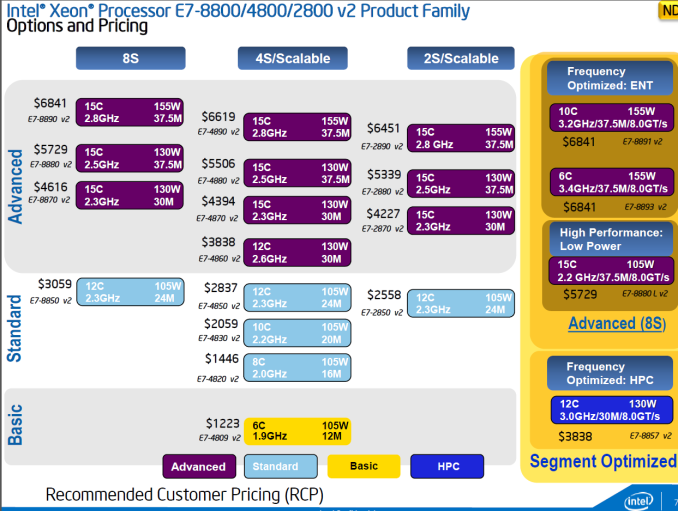The Intel Xeon E7 v2 Review: Quad Socket, Up to 60 Cores/120 Threads
by Johan De Gelas on February 21, 2014 6:00 AM EST- Posted in
- IT Computing
- Intel
- Xeon
- Ivy Bridge EX
- server
- Brickland
SKUs and Prices
Anno 2014, the only competition for the Xeon E7 v2 are the—ranging from expensive to "Exa" expensive—Oracle Superclusters, the relatively "cheap" but lowly specced IBM Power 710/720 Server Express line, or the powerful but rather expensive IBM Power 760-780 server line. As a result, the prices for Ivy Bridge EX are a lot more "RISCy". Intel feels that you should get 20% to 50% more performance for the same amount of money...
... but feels that a premium price is warranted for the two top models (4890 and 4880 v2) that offer higher performance increases. That leads to some hefty price tages:
One of the most interesting SKUs seems to be the Xeon E7-8857 v2, a native 12-core at a pretty high 3GHz clock, and which only costs 60% of the other top models.












125 Comments
View All Comments
JohanAnandtech - Friday, February 21, 2014 - link
I don't see the error. "Beckton" (Nehalem-EX, X7560) is at 2.4 GHzmslasm - Sunday, February 23, 2014 - link
> I don't see the error.The article says "The Opteron core is also better than most people think: at 2.4GHz it would deliver about 2481 MIPs." - but, according to the graph, Opteron already delivers 2723 @ 2.3Ghz. So it is puzzling to see that it "would" deliver less MIPS (2481 vs 2723) at higher frequency (2.4 vs 2.3 Ghz) (regardless of any Intel results/frequencies)
silverblue - Saturday, February 22, 2014 - link
It's entirely possible that the score is down to the 6376's 3.2GHz turbo mode.plext0r - Friday, February 21, 2014 - link
Would be nice to run benchmarks against a Quad E5-4650 system for comparison.blaktron - Friday, February 21, 2014 - link
... you know you can't, right?blaktron - Friday, February 21, 2014 - link
Nevermind, read v2 there where you didn't write it. Too much coffee....usernametaken76 - Friday, February 21, 2014 - link
For the more typo-sensitive reader (perhaps both technically astute and typo-senstive):"A question like "Does the SPARC T5 also support both single-threaded and multi-threaded applications?" must sound particularly hilarious to the our technically astute readers."
...to the our...
JohanAnandtech - Friday, February 21, 2014 - link
Fixed. Thx!TiGr1982 - Friday, February 21, 2014 - link
From the conclusion:"The Xeon E7 v2 chips are slated to remain in data centers for the next several years as the most robust—and most expensive—offerings from Intel."
I don't think it will be really "several" years - maybe 1-2 years later this Ivy Bridge-EX-based E7 v2 will probably be superseded by Haswell-EX-based E7 v3 with Haswell cores with AVX2/FMA, which should make a difference in pro floating point calculations and data processing, and working with DDR4.
Kevin G - Friday, February 21, 2014 - link
The Ivy Bridge-EX -> Haswell-EX transition will mimic the Nehalem-EX -> Westere-EX transition in that the core systems provided by the big OEM will stay the same. The OEM's offer Haswell-EX as a drop in replacement to their existing socket 2011v1 systems. Haswell-EX -> Broadwell-EX will again be using the same socket and follow a similarly quick transition. SkyLake-EX will bring a new socket design (perhaps with some optical interconnects?).At some point Intel will offer new memory buffer chips to support DDR4. This will likely require a system to swap out all the memory daughter cards but the motherboard from big OEM's shouldn't change. There may also be a period where these large systems can be initially configured with either DDR3 or DDR4 based upon customer requests.